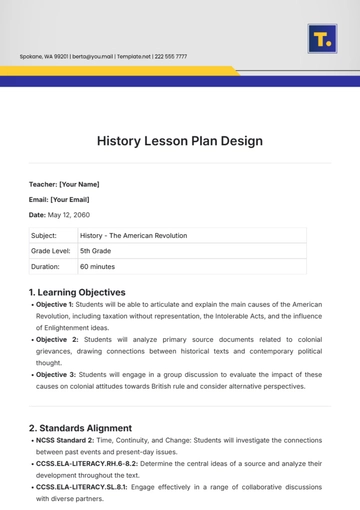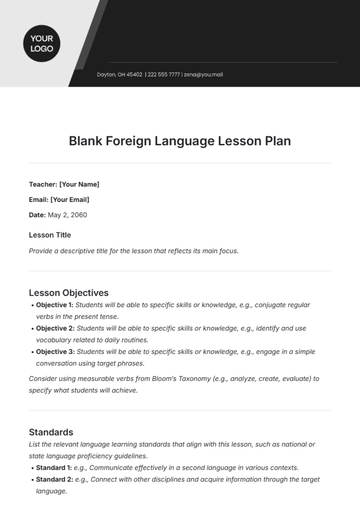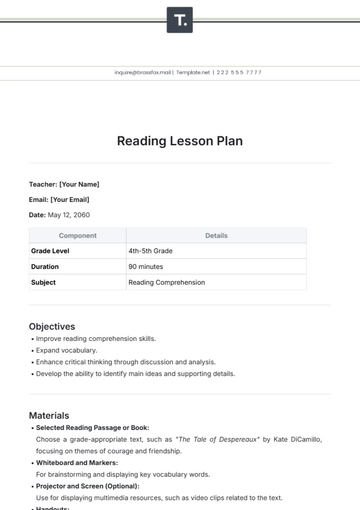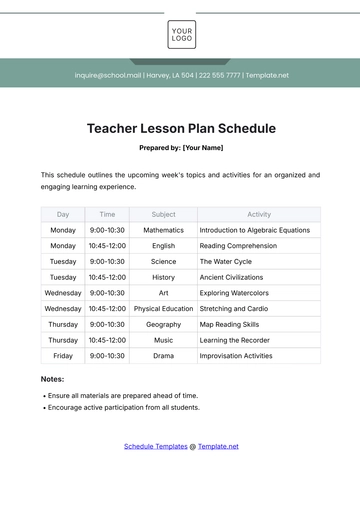Free Psychology Lesson Plan

Instructor | [YOUR NAME] |
|---|---|
Institution | [YOUR COMPANY NAME] |
Course | PSYCH 103 |
I. Lesson Overview
This lesson plan is designed to foster a comprehensive understanding of psychology by integrating its concepts into various interdisciplinary subjects, including sociology, health education, and counseling. By exploring the intersection of psychology with other disciplines, students will gain insights into human behavior and societal dynamics, enhancing their critical thinking and problem-solving skills.
II. Learning Objectives
Understand the relevance of psychology in interdisciplinary studies:
Students will recognize the importance of psychology in providing insights into human behavior and addressing complex societal issues.
Identify connections between psychological concepts and other subject areas:
Students will analyze how psychological theories and principles intersect with sociology, health education, and counseling.
Apply psychological theories to analyze and solve real-world problems:
Students will apply psychological concepts to analyze case studies and scenarios, identifying practical solutions to real-world challenges.
Enhance critical thinking and communication skills:
Through interdisciplinary discussions and activities, students will develop critical thinking skills and learn to communicate effectively about psychological concepts in diverse contexts.
III. Target Audience
This lesson plan is tailored for high school students in grades 10-12, encompassing an age range typically characterized by increased cognitive development and the ability to engage in critical thinking and abstract reasoning. However, the content and activities can be adjusted to suit the needs and abilities of middle school or college-level learners.
A. Rationale for Target Audience Selection
Developmental Relevance: High school students are at a stage where they are developing a deeper understanding of themselves and the world around them, making them receptive to exploring interdisciplinary connections.
Curricular Alignment: The lesson plan aligns with the curriculum standards for high school psychology courses, allowing educators to seamlessly integrate it into existing coursework.
Preparation for Higher Education: By exposing students to interdisciplinary approaches early on, the lesson plan aims to prepare them for future academic pursuits and careers that require multidisciplinary thinking and problem-solving skills.
Engagement and Interest: The lesson plan incorporates interactive activities and real-world applications to maintain student engagement and foster a passion for learning about psychology and its intersections with other disciplines.
B. Adaptability
While designed for high school students, the lesson plan is flexible and can be adapted to suit the needs of learners at different educational levels or with varying levels of prior knowledge in psychology. Educators can modify the complexity of activities, adjust the pace of instruction, or provide additional support as needed to ensure all students can actively participate and achieve the learning objectives.
IV. Materials Needed
To facilitate effective learning and engagement during the lesson activities, the following materials are recommended:
A. Textbooks or Online Resources
Access to textbooks or reliable online resources covering a broad range of psychological theories and principles is essential. These resources will serve as reference materials for both the educator and students, providing comprehensive information and explanations of key concepts.
B. Worksheets or Handouts
Prepared worksheets or handouts will be distributed to students to guide their participation in various activities throughout the lesson. These materials may include prompts for brainstorming sessions, case studies for analysis, and exercises for applying psychological theories to real-world scenarios.
C. Whiteboard and Markers
A whiteboard and markers will be utilized for visual aids and group discussions. The whiteboard can be used to jot down key points, diagram concepts, or illustrate connections between psychology and other disciplines, enhancing students' understanding through visual representation.
D. Multimedia Resources (Optional)
Optional multimedia resources, such as educational videos, interactive simulations, or online presentations, can supplement the lesson activities and provide additional context or examples. These resources may help cater to diverse learning styles and enhance students' engagement with the material.
V. Lesson Activities
Activity | Duration | Description |
|---|---|---|
A. Introduction to Interdisciplinary Studies | 30 minutes |
|
B. Exploring Psychological Concepts in Sociology | 45 minutes |
|
C. Integrating Psychology into Health Education | 45 minutes |
|
D. Applying Psychological Principles in Counseling | 45 minutes |
|
VI. Assessment
Completion of worksheets or assignments related to each interdisciplinary activity, demonstrating understanding of psychological concepts and their application in different subject areas.
Participation in group discussions and activities, showcasing critical thinking skills and ability to communicate effectively about psychological concepts in interdisciplinary contexts.
Performance in role-plays or simulations, evaluating students' application of psychological principles in real-world scenarios and their ability to provide constructive feedback on their own and their peers' performances.
VII. Conclusion
Through this lesson, students have explored the integration of psychological concepts into interdisciplinary studies, gaining insights into human behavior and societal dynamics. By recognizing the connections between psychology and other subjects, students have developed critical thinking skills and enhanced their ability to address real-world challenges from a multidisciplinary perspective. This lesson equips students with valuable knowledge and skills that are essential for success in various academic and professional endeavors.
- 100% Customizable, free editor
- Access 1 Million+ Templates, photo’s & graphics
- Download or share as a template
- Click and replace photos, graphics, text, backgrounds
- Resize, crop, AI write & more
- Access advanced editor
Boost your teaching efficiency with Template.net's Psychology Lesson Plan Template. This customizable and editable resource is designed to simplify your lesson planning process. Utilize the AI Editor Tool to tailor each lesson to your unique needs, ensuring a seamless and engaging learning experience for your students. Perfect for seeking an organized approach to psychology.





























